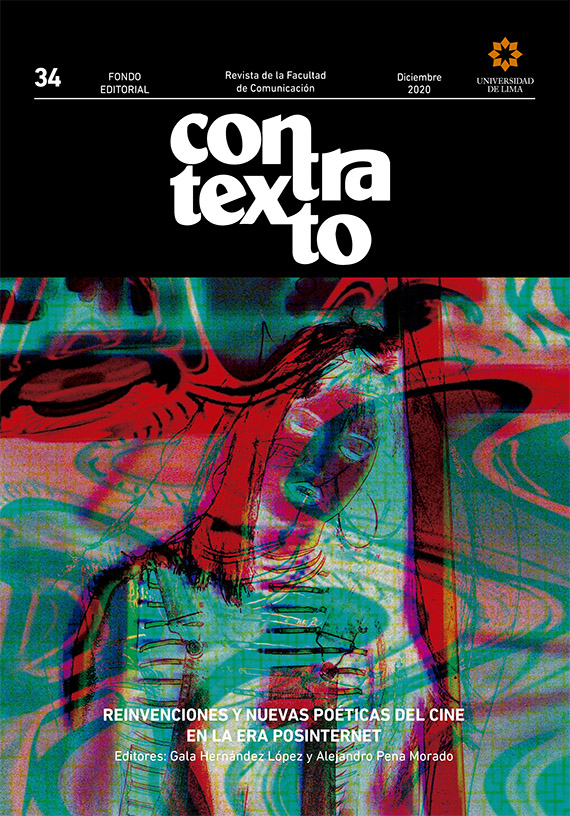Rewriting the horror genre through new digital realities in Cam by Daniel Goldhaber
DOI:
https://doi.org/10.26439/contratexto2020.n034.4868Keywords:
Film studies, horror, doppelgänger, digital, genre filmsAbstract
This article seeks to explain how the film Cam works with some themes of the horror genre (the doppelgänger, or double, in particular) to show how the new digital technologies have change the dynamics of our everyday life. The film offers, based in the story of a cam girl whose identity is taken by an unknown entity, a look on how digital technologies have become work and provision tools, creating a new life dynamic in which we don´t need to shift and everything can be done with a click. The film also exposes the new forms of the horror genre, showing Internet as a place where violence and sex have become tools to generate interactivity with users, and allowing better profits. But Cam also works with some contemporary fears that come with the new technologies (to be blocked from an account, the possibility of being hacked) to create a universe where all explanations are possible, and where it´s very hard to establish which is the enemy to beat.
Downloads
References
Bordwell, D (2003). Arte Cinematográfico. McGraw-Hill/Interamericana Editores.
Castells, M (1999). La era de la información. Economía, sociedad y cultura. La sociedad red. Vol 1. Siglo XXI Editores.
Ehrlich, D. (2018). ‘Cam’ Review: A Brilliant Madeline Brewer Anchors a Lynchian Horror Movie About a Cam Girl in Crisis - Fantasia 2018. Indiewire. https://www.indiewire.com/2018/07/cam-review-daniel-goldhaber-madeline-brewer-fantasia-2018-1201985605/
Gledhill, C (1999). The Horror Film. En P. Cook & M. Bernink (Ed.), The Cinema Book (pp. 194-204). British Film Institute.
Goldhaber, D. (2018). Cam [Película]. Divide/Conquer.
Gubern, R. & Prat, J (1979). Las raíces del miedo. Antropología del Cine de Terror. Tusquets Editores.
Imbert, G. (2010). Cine e imaginarios sociales. Ediciones Cátedra.
Imbert, G. (2019). Crisis de valores en el cine posmoderno (Más allá de los límites). Ediciones Cátedra.
Meehan. P (2017). The Ghost of One´s Self, Doppelgängers in Mystery Horror and Science Fiction Film. McFarland & Company, Inc., Publishers.
Perceval, J.M. (2015). Historia mundial de la comunicación. Ediciones Cátedra.
Scolari, C. (2008). Hipermediaciones. Elementos Para Una Teoría de la Comunicación Digital Interactiva. Editorial Gedisa, S.A.
Waisbord, S. (2019). Communication. A post-discipline. Malden Polity Press.
Wood, R. (Ed.). (2018). An Introduction to the American Horror Film. En Robin Wood on the Horror Film. Collected Essays and Reviews (pp.73-110). Wayne State University Press.
Downloads
Published
Issue
Section
License
All of the works published are licensed under a CC BY 4.0 Creative Commons Attribution license. (updated on March 1st 2021)
The content of the journal may be shared in any material or format. The content may be adapted, contributed upon and transformed. Both possibilities are only permitted in so far as they complete the following conditions:
- Attribution: Credit must be given where it is due, a link to the license must be provided and changes, if made, must be indicated. This should be done in the manner deemed appropriate, without suggesting that the licensor promotes you or your use of the material.
Ownership rights
The patrimonial rights for Contratexto are published under a Creative Commons BY 4.0 license, allowing authors to keep the patrimonial rights to their work without restrictions.
If a work published in Contratexto were to be copied, distributed, spread, or any other activities contemplated in the aforementioned license, the author(s) and the journal must be mentioned visibly and expressly.
Self-archive
This journal allows and encourages authors to post items submitted to the journal on personal websites or institutional repositories both prior to and after publication, while providing bibliographic details that credit, if applicable, its publication in this journal.


